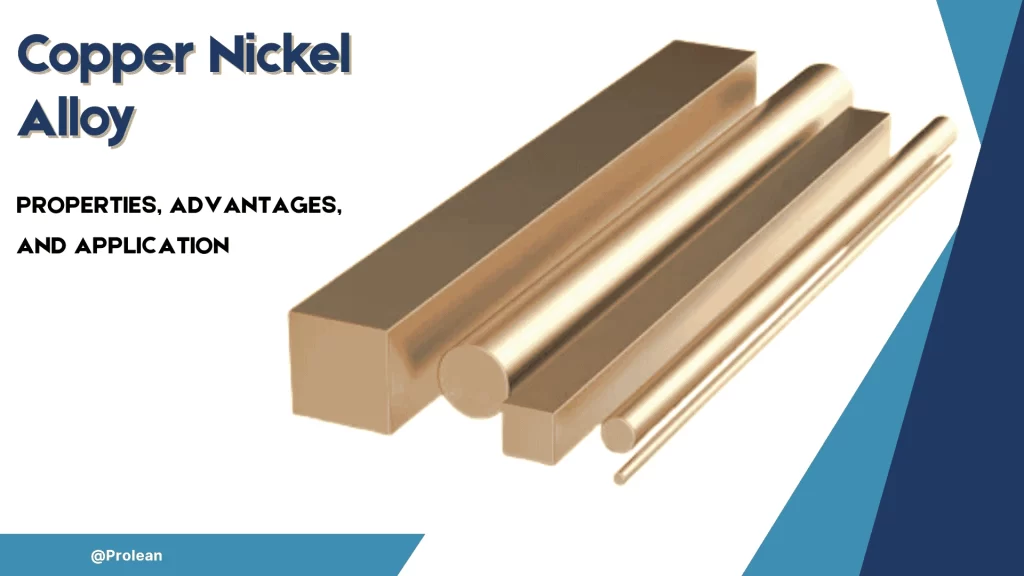
Copper is an orange-red metal with excellent electrical conductivity, corrosion resistance, and anti-bacterial properties. Nickel is a shiny, silvery metal that offers high strength, toughness, and chemical resistance.
Combining these two metals in different proportions at the metallurgical level forms copper nickel alloys (CuNi). They leverage the benefits of copper and nickel, offering a balance of corrosion resistance, ductility, and thermal & electrical conductivity.
Understanding the types of copper nickel alloys, their composition & properties, advantages, disadvantages, applications, and cost implications can help in the CNC machining material selection or any other manufacturing project. So, let’s discuss these aspects of CuNi alloys in detail.
What is Copper Nickel Alloy?
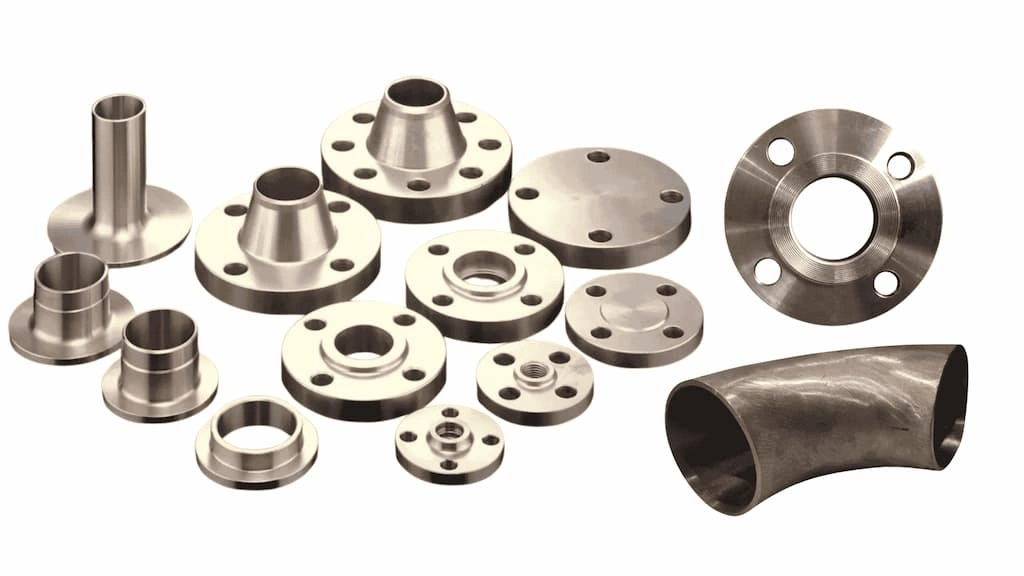
Cupronickels parts
A Copper Nickel alloy, CuNi alloy, or copper-nickel all refer to a metal alloy formed by the metallurgical combination of copper and Nickel. The pure copper and nickel are melted together and cast into different shapes. Here, the alloy is cast with a microstructure unique to both parent metals. The nickel atoms substitute into the copper lattice and form a new continuous FCC crystal structure.
Like every other alloy material, the ratio of alloying elements in the mixture can vary based on alloy type. In Cu-Ni alloys, the percentage of nickel ranges from 10 to 45 %. As the amount of nickel increases in the composition, it becomes tougher, but less machinable. Meanwhile, alloy grades with
In addition to copper & nickel, manganese and iron are also added in small amounts, approximately 2%. These additives further enhance the resistance against corrosion. Tin and aluminum are also added to some alloys to make them favourable in high-performance applications.
Physical Properties of Copper Nickel Alloys
Copper Nickel alloys do not rust easily, have good ductility, and can be shaped into pipes, tubes, and complex parts. Additionally, it is denser than pure copper.
| Property | Cu-Ni 90/10 | Cu-Ni 70/30 |
| Density (g·cm⁻³) | 8.9 | 8.95 |
| Specific heat (J·kg⁻¹·K⁻¹, ≈20°C) | 377 | 377 |
| Thermal conductivity (W·m⁻¹·K⁻¹, ≈20°C) | 50 | 29 |
| Linear coefficient of thermal expansion (10⁻⁶ K⁻¹, 10–300°C) | 17 | 16 |
| Electrical conductivity (% IACS) | 9% IACS | 4% |
Mechanical Properties of Copper Nickel Alloys
Copper nickel alloys have good mechanical strength, wear resistance, and fatigue resistance. They also provide a good elongation and moderate hardness.
| Property | Cu-Ni 90/10 | Cu-Ni 70/30 |
| Young’s modulus (GPa) | 135 | 150–152 |
| Shear modulus (GPa) | 50 | 57 GPa |
| Poisson’s ratio | 0.34 | 0.34 |
| Tensile strength (MPa) | 300–420 MPa | 372–517 |
| Yield strength (MPa) | 100 MPa | 120–130 |
| Elongation (% ) | 30% | 30–45% |
| Hardness (HV) | 85–95 | 95–110 |
Try Prolean Now!
Types of Copper Nickel Alloys
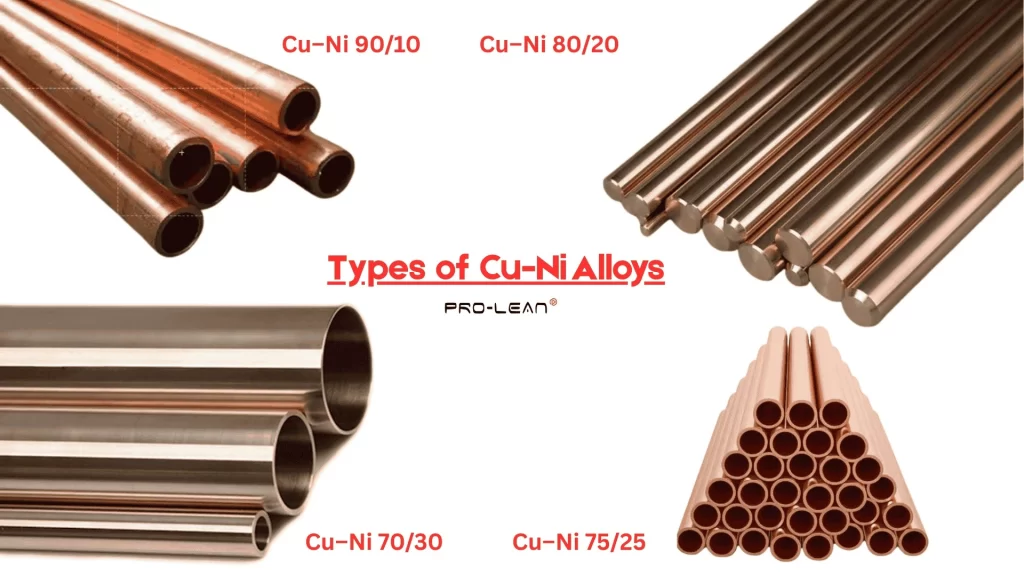
Types of CuNi Alloys
Based on the percentages of nickel & copper in the composition, there are different types of Copper Nickel, each one offers slightly different properties. It includes Cu-Ni 90/10, Cu-Ni 70/30, Cu-Ni 80/20, and Cu-Ni 75/25.
Let’s briefly elaborate on these alloys of copper and nickel:
Cu–Ni 90/10
This alloy contains 90% Cu and 10% Ni, while manganese and iron are added in approximately 1 %. You can consider this as an equivalent of UNS C70600 alloy. Moreover, it is also a marine-grade material that offers good ductility, weldability, and corrosion resistance in seawater. Cu-Ni 90/10 is used in marine hardware, piping, shipbuilding, and heat exchangers.
Cu–Ni 70/30
The increased amount of nickel increases the mechanical strength and corrosion resistance. It has slightly better elongation properties. The 70/30 alloy also resists rust formation in moving water and a marine environment. Moreover, it is equivalent to UNS C71500 alloy.
You can use this for applications handling higher mechanical loads, such as water treatment plants, offshore piping, and condenser tubing. However, the higher % of nickel drives the alloy cost.
Cu–Ni 80/20
Cu-Ni 80/20 is equivalent to Cu–Ni 80/20 and is also referred to as the intermediate grade of Cu-Ni 90/10 and 70/30. It provides good corrosion resistance and slightly less mechanical strength. The uses can be seen in tubing, wiring, architecture & decoration, and some seawater hardware.
Cu-Ni 75/25
This type of copper nickel alloy is popular in coin-making & production of decorative items. It provides excellent corrosion resistance, good ductility, wear resistance, and aesthetic appeal. In the market, you can also find a 75/25 alloy optimized for metal stamping.
Advantages of Copper Nickel Alloys
The copper-nickel alloys leverage the properties of both parent metals and offer several benefits in manufacturing. The alloys become highly corrosion-resistant. Meanwhile, they can be shaped into desired parts and can also be recycled.
Furthermore, cupronickels are superior to zinc and copper alloys when it comes to marine and harsh environments.
Now, let’s look at the five key advantages of copper nickel alloys:
- Corrosion-resistance: Cupronickel alloys offer superior corrosion resistance in saltwater and other harsh environments.
- Antibacterial: They are antibacterial and suitable for some pharmaceuticals & cryogenic applications. It is also beneficial in marine environments as it discourages marine organisms.
- Thermal Stability: Cu-Ni alloys do not lose their properties at high temperature, usually up to 650 °C. Plus, they can withstand cyclic thermal stress.
- Machinability & Formability: The copper nickels can be CNC machined into complex parts, whereas the sheets can be formed into various shapes with fabrication processes. Also, the parts can be joined with welding and brazing.
- Conductivity: The alloys possess excellent heat transfer properties and electrical conductivity. So, they are beneficial for wiring, connectors, and heat-exchangers.
Disadvantages of Copper Nickel Alloys
Although copper nickels are extremely useful materials in machining & metal fabrications, they also have some limitations. Especially, the cost implications and low machinability of some grades.
The following are the disadvantages of cupronickel alloys:
- Costlier than Other Alloys: Compared to alluminum extrusion alloy and stainless steel alloys, copper nickel is more expensive.
- Machinability: Some grades, like Cu-Ni 70/30, are less machinable, and they might need tools with a hard coating.
- Sensitive to welding Contamination: Although Cu-Ni alloys have high weldability, they are more prone to welding contamination and require precise temperature control.
Try Prolean Now!
Applications of Copper Nickel (CuNi) Alloys
Due to several beneficial properties, CuNi alloys are used in the marine, piping, electrical, architectural, and other fields. Often, these are the best alternatives to stainless steel in seawater systems and components.
Let’s look at the major applications:
Copper Nickel Pipes and Pipe Nipples 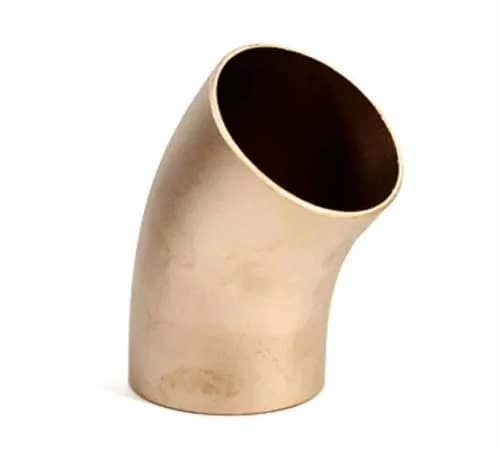
Pipe Nipple
The biofueling and corrosion resistance make copper nickel pipe excellent for use under seawater and in offshore platforms. Consequently, pipe nipples are the short sections of pipe having threads on both ends; they are used in fittings and piping extensions.
Application Examples: fittings, flanges, valves, offshore piping, intake/outlet systems, piping for corrosive fluids in industries.
Cooling Loops
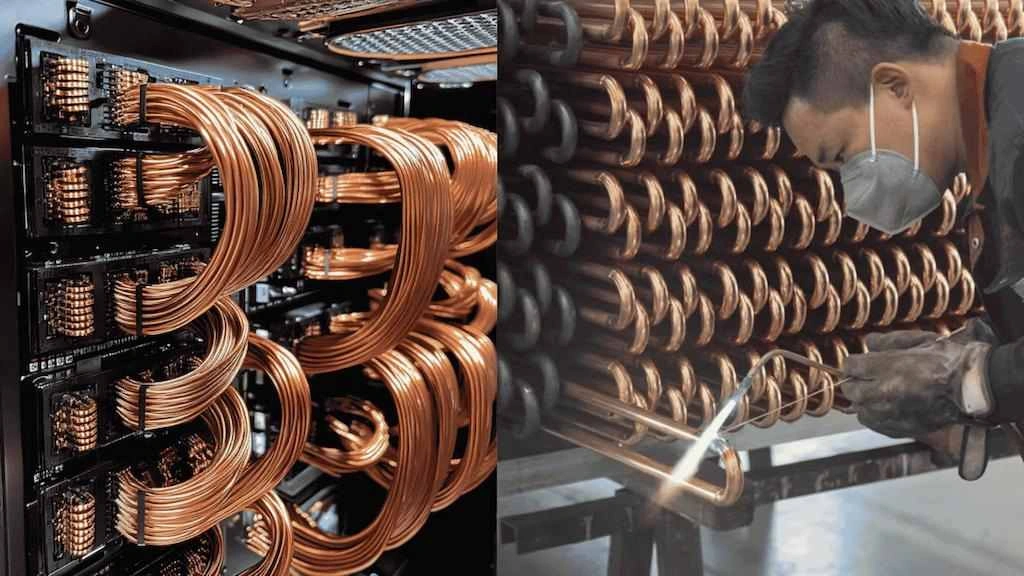
CuNi copper loops
Cooling loops are the network of closed or semi-closed tubes. They allow the coolant to flow inside and are used to disperse the heat from machines, tools, equipment, and systems. Due to excellent heat transfer properties, Cupronickels is suitable for this application.
Application Examples: seawater cooling circuits, HVAC & refrigeration, power plants, condensers, etc.
Shipbuilding
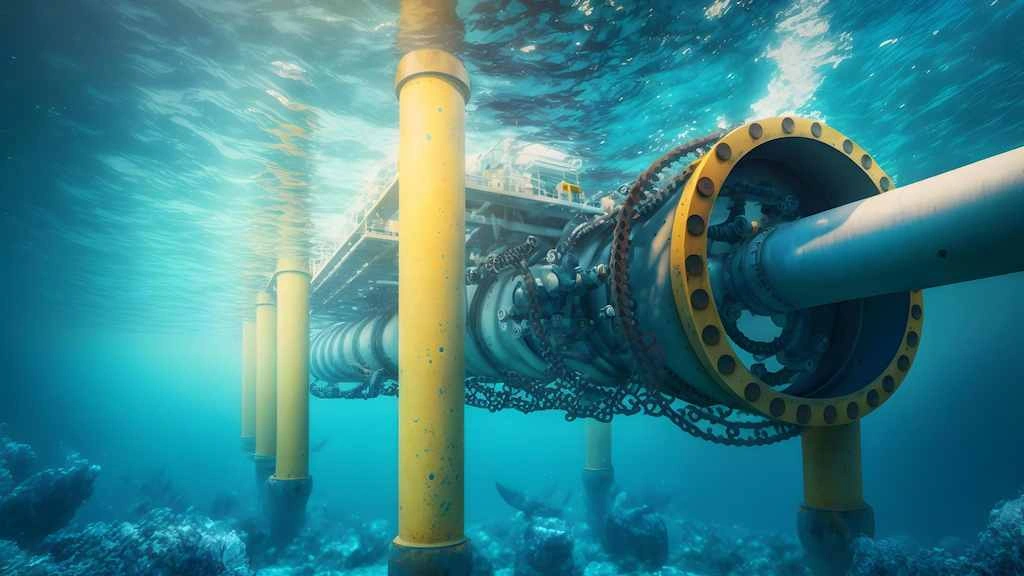
Seawater piping system
Copper Nickels are used in ship construction, interior, and various auxiliary systems. Strength of copper-nickel, durability, low biofouling tendency, and resistance against seawater erosion make them useful in shipbuilding.
Application Examples: Components for underwater equipment, hydraulic lines, offshore structures, cargo heating coils, pump components, ship hulls, and bilge & ballast piping.
Desalination Plants
CuNi alloys are well-suited for desalination plants, whether they have a single or multiple stages. It can withstand salt water without degrading the surface over a long time.
Application Examples: Evaporator chamber piping, heat recovery section, brine heater tubes, nozzles for flash chambers, valves, and fittings.
What is the Importance of Copper Nickel?
The combination of copper and nickel allows you to leverage both of their properties. Alloys become more ductile than nickel and tougher than copper. Besides this, they offer thermal stability at elevated temperatures. Using alloys also helps reduce material costs; their prices are less than pure nickel.
The above properties make copper nickel significantly important in marine systems & equipment, industrial and seawater piping, heat exchangers, and the electrical industry.
Furthermore, you can also customize the properties as you need by altering the proportion of nickel, copper, and other alloying elements ( minor amounts).
Cu-Ni Alloy Vs Titanium Alloy Vs Alloy Steel 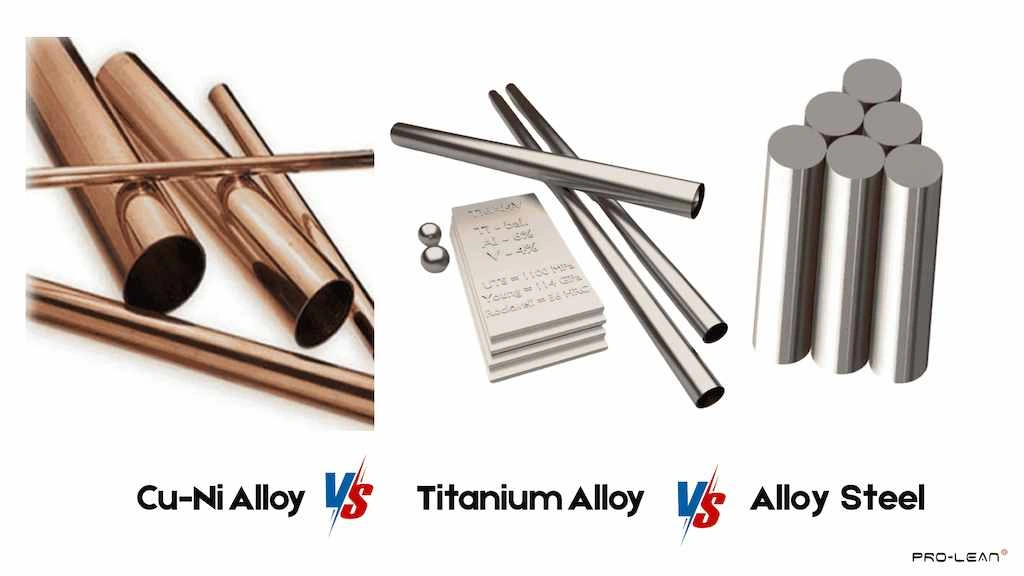
CuNi vs other alloys
Titanium alloys are tougher than CuNi and offer a higher strength-to-weight ratio, but they are costlier. Titanium alloy grades like Ti-6Al-4V, Ti-3Al-2V, and Ti-6Al-4V ELI are popular in CNC machining.
Alloy steels are formed by alloying multiple elements in iron, such as chromium, nickel, vanadium, molybdenum, sulfur, and phosphorus. Meanwhile, the difference between alloy steel vs carbon steel is that carbon steel includes a high % of carbon, but does not involve so many alloying metals.
The table below provides a comparative overview of Cu-Ni vs titanium vs steel alloy:
| Criteria | Cu-Ni Alloys | Titanium Alloys | Alloy Steel |
| Tensile Strength | Moderate | High | Higher than Cu-Ni, lower than Ti-alloys |
| Corrosion Resistance | Excellent in seawater | Excellent in an aggressive environment | Good |
| Temperature Resistance | Moderate (~300°C) | Excellent (up to ~600°C) | Good to Excellent, depends on alloy grade |
| Weight | Moderate | Light | Heavy |
| Cost | Moderate to High | High | Low to Moderate |
| Common Applications | Marine hardware, heat exchangers | Aerospace, medical implants, chemical processing | Automotive, construction, machinery |
Read More:
Summing Up
What makes Copper Nickel alloys unique is their excellent corrosion resistance in seawater and good mechanical strength. They are also good conductor of heat and electricity. Therefore, CuNi has extensive applications in marine,
At the end, to convert the raw copper nickels into a useful part or product, you require manufacturing equipment and expertise. At ProleanTech, we help you craft functional components of Cu-Ni using CNC milling, turning, drilling, EDM, metal forming, and other various technologies.
Not only cupronickels, our CNC machining services provide 100+ material options, including metals, alloys, plastics, and composites. Meanwhile, we are also flexible in customization and production volumes. Drop your design into our quotation platform, or you can read the FAQs about our offerings.
FAQs
What is CuNii?
CuNi is a notation for copper nickel alloys, also called cupronickel. They are made with 10 to 45% of nickel, 65 to 90% of copper, and 1-2% of manganese and iron.
What is copper-nickel alloy used for?
The copper nickel alloy is used in conditions like seawater, corrosive exposure, and high thermal exposure.
Is Copper Nickel Alloy Expensive?
Yes, it is expensive than most other CNC machining alloys like stainless steel and aluminum alloys. However, the price is justified in most of the applications.
What Is the Strength Range of Copper-Nickel Alloys?
The exact strength depends on the type of alloy (90/10, 70/30, 80/20) and heat treatment. But the tensile strength falls in the range of 300 to 520 MPa.
Is CuNi Alloy Safe?
Yes, CuNi alloy is safe for water systems, heating, and condensation. Some grades are even safe for food processing and medical uses.

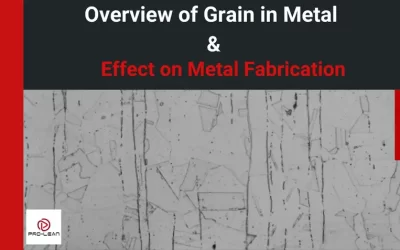
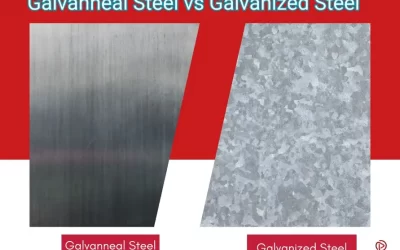
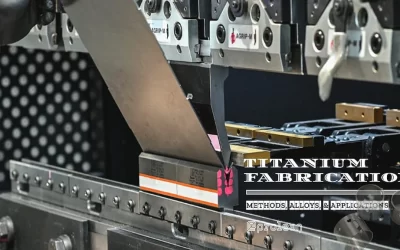
0 Comments